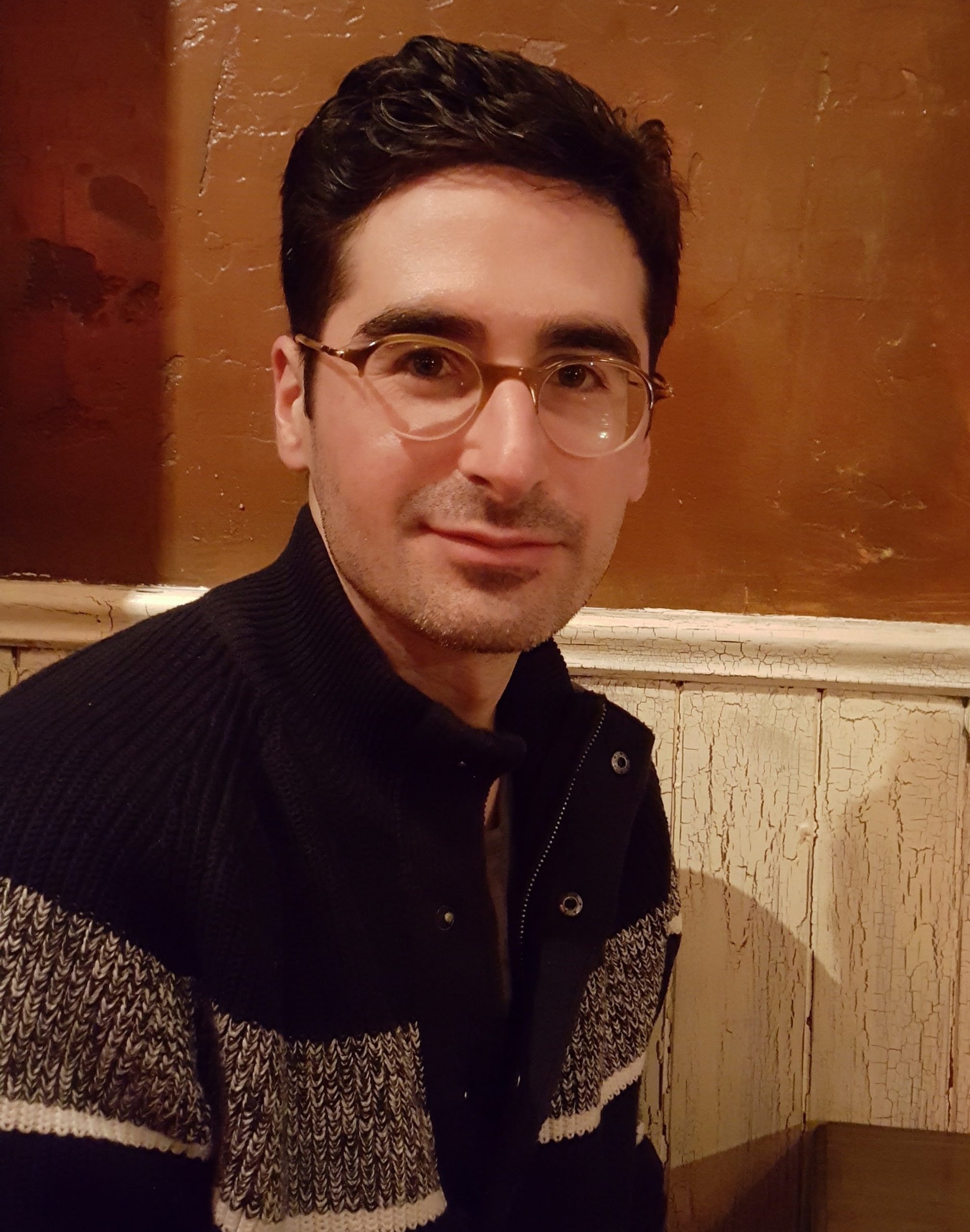By Trevor Mowchun
Preamble
Space in cinema is an often under-appreciated if not altogether neglected aspect of the medium. This may be because, at first glance, the physicality of space lacks the dreaminess of time. But the physicality of space is more than just a container of things: it is a context in which things make sense. Cinema may be routinely defined as a temporal art form, but let’s not forget that it is a profoundly spatial art form which must be built before it can breathe. On film, stories are spatialized at every moment of their unfolding, and the spaces that flourish most meaningfully are as instruments to the voice of time. Knowledge of the subtle dynamics of cinematic space and insight into how to dramatize what we call “setting” or “location” is crucial for an understanding of how films work, not only thematically but architecturally—as livable for their characters and discoverable for their viewers who for the most part are not seeking total immersion.
In the Spring semester of 2020 at the University of Florida, I developed an advanced filmmaking course on “cinematic space” as an aspect of the medium that, if handled carefully and maximized artistically, any narrative no matter how simple or abstract could grow as if out of a pot of earth. In this sense I was guided by the belief that stories indifferent to the spaces in which they are set lack roots. I stressed the imaginative possibilities of creating films set in a limited number of spaces or even a single space, e.g., a house, apartment complex, campground, restaurant, elevator, bus, or even a space as inconspicuous as a closet. The expressive range of single-space films can be remarkably broad, whether the filmmaker opts to expand a space beyond its apparent limits and into a “world” or, just the opposite, to implode the space into an experience of confinement in which the characters are pressured to reveal hidden depths of the human psyche. Whatever the approach, I discovered that an appreciation of space in cinema can form the foundation for an independent filmmaking process that is both imaginative and practical. Working with rather than against the constraints of cinematic space can yield surprisingly liberating conditions for tapping into artistic possibilities difficult to imagine when the filmmaker’s vision is set too high in terms of narrative scale and complexity.
What follows is a sample of the teaching illustrations I produced throughout the semester which attempt to visualize the inner workings of cinematic space as evidenced by films that struck me as instructive or masterful in this regard. Each drawing takes a slightly different cartographic approach depending on the key locations, spatial turns, and overall aesthetic patterns of the film. These illustrations served as my foundation in guiding filmmaking students through the art of screen space. I reached the conclusion more than once that much of a film’s power can depend on the subordination of time to space: a story cuts a course through a world it never fully exhausts. I think this is true of all art forms to a certain extent, but with cinema it is an inescapable practice.
Map 1: “Single-Space Cinema”
Case study: Film (Samuel Beckett & Alan Schneider, UK, 1965)
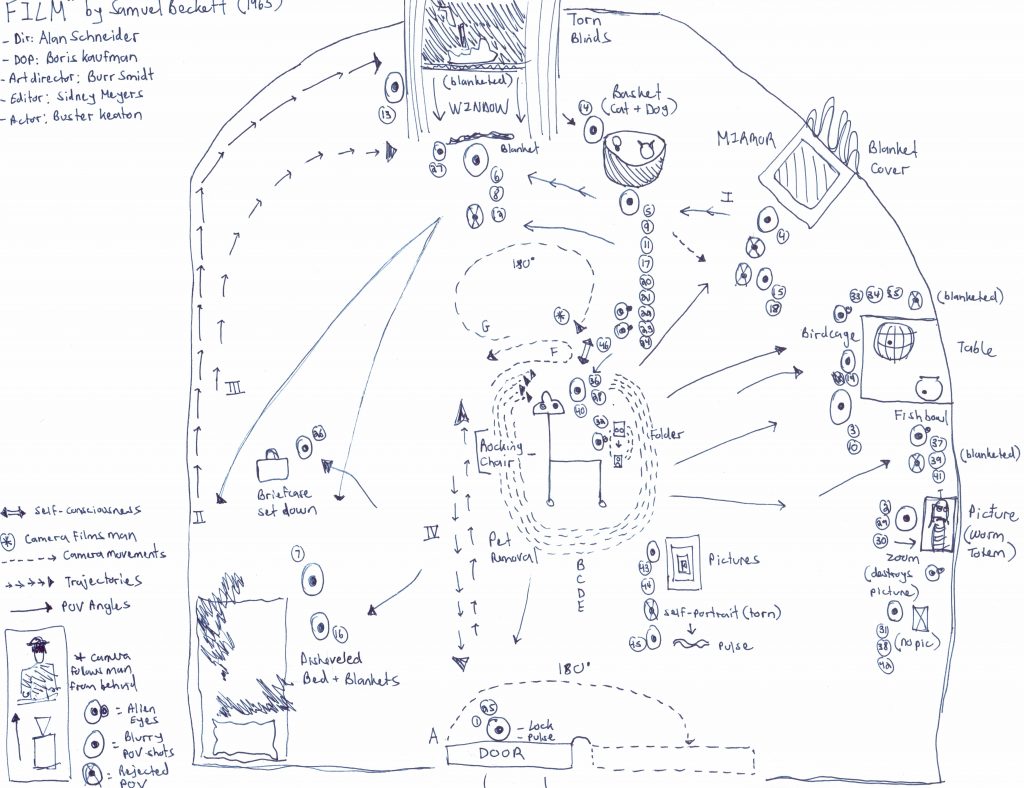
Commentary:
The shortest and seemingly simplest film of the lot yields the most complicated map, perhaps more confusing than clarifying. In principle, maps are meant to elucidate spatial connections or orient the lost, yet their complexity can resemble a spider’s web in which the viewer can feel trapped. The bedroom space at the heart of Beckett’s Film is sparse, like all of the playwright’s sets (i.e. Waiting for Godot, Endgame), and the choreography within it is absurdly repetitive, again like much of his theater in general. So why so complex? The repetitions of life (intolerable to most film narratives) accumulate into layers of meaning; sense strata. The world is old and deep and multilayered because of eternal repetition.
What the map does reveal rather clearly, I think, is that this room has a core—a chair. Throughout the lengthy sequence, the room’s owner and inhabitant, a man referred to in Beckett’s script as “O”, played by none other than Buster Keaton, circles the chair four times (camera movements B – C – D – E), each time sitting down in the center of the room where the ego is safely enthroned. That is the only place where he, this man, this “I”, feels at ease: at the center. Earlier we saw him anxiously examining the wall on the left-side of the room, as if he were walking along a dangerous precipice (character trajectories II – III), a path that leads him to the room’s lone window concealed by a thick black torn blanket.
While mapping the room and numbering the shots one by one, I was surprised to discover that this window, although largely concealed like a shut eyelid, stands at the apex of a space whose shape resembles the curvature of the eye. This only became clear as I followed the man’s movements along a wall that seemed to be missing its pivotal corner. The thought of being able, courtesy of the window, to see outside of himself and into the world, and thus risk being seen, perhaps by someone walking along the street below, must have been one of the causes of his unbearable unease. The brush with exteriority convinces him of the urgency to retreat to the center of the room, the citadel of the lonely yet sweetly self-contained self. And it is from this pillar of being that he can safely venture out into what is, for him, a world in its own right, full of various unassimilable attachments: The Room.
His room, of course. Here, nothing becomes truly his until he flips his gaze upon it in a constituting jab. To gaze at something so desperately, without purpose except to know or to confirm, is a darkening (designated on the map as “Blurry POV Shots”). This cruel gaze meets things with a gaze of their own—dog, cat, fish, bird, picture of a worm—all of the creaturely realm, and all without a rock-solid or relatable sense of agency (designated as “Alien Eyes”). The back of the rocking chair and a folder handled by the man (“O”) both have patterns resembling eyes as well. Eyes come in twos except for the window, the camera, and as we discover at the end, the man himself who wears an eyepatch. The holes on the back of the rocking chair give him eyes at the back of his head. He would like that very much. Some things which his eyes see seem to place a great strain on his mind: window, mirror, photographs. These objects in particular have the power to reject the man’s gaze (“Rejected POV Shots”)—perhaps because as objects they uncannily reproduce objects and so cannot be known in themselves. Sight cuts itself on these powerful objects which see into the future (window), or into the past (photograph), or into the self (mirror). The sheer ease with which he blocks the future, erases the past, avoids himself, captures the tragedy of the aging clown of silent cinema whose glory days are long behind him. What is left for him, of him?
Movement G on the map is decisive because it shows the moment when the camera turns on the man, finally revealing the face of he who is all eyes; or a single eye which, like the window, refuses to open up to the fresh air of another person’s analogous plight. Like those before him caught by the camera’s crushing gaze, the shock of self-consciousness (designated as ↔) is followed by deep resignation and exhaustion. Though he never speaks, his distress seems to say: “You have roused me from the dream of myself. Never allowing myself to be seen, I live in shame. When looking at you I will always see that you see me. I will constantly wonder just how you see me, or I will take pains to ensure you see me as I am—but that’s not who I am. Who am I? I. I am fully absorbed in the business of being myself, you see. I have much to make mine, you see, and little time to spare on those who are too much like me.”
Map 2: “Spatial Patterns of the Opening Sequence”
Case study: Woman in the Dunes (Hiroshi Teshigahara, Japan, 1964)
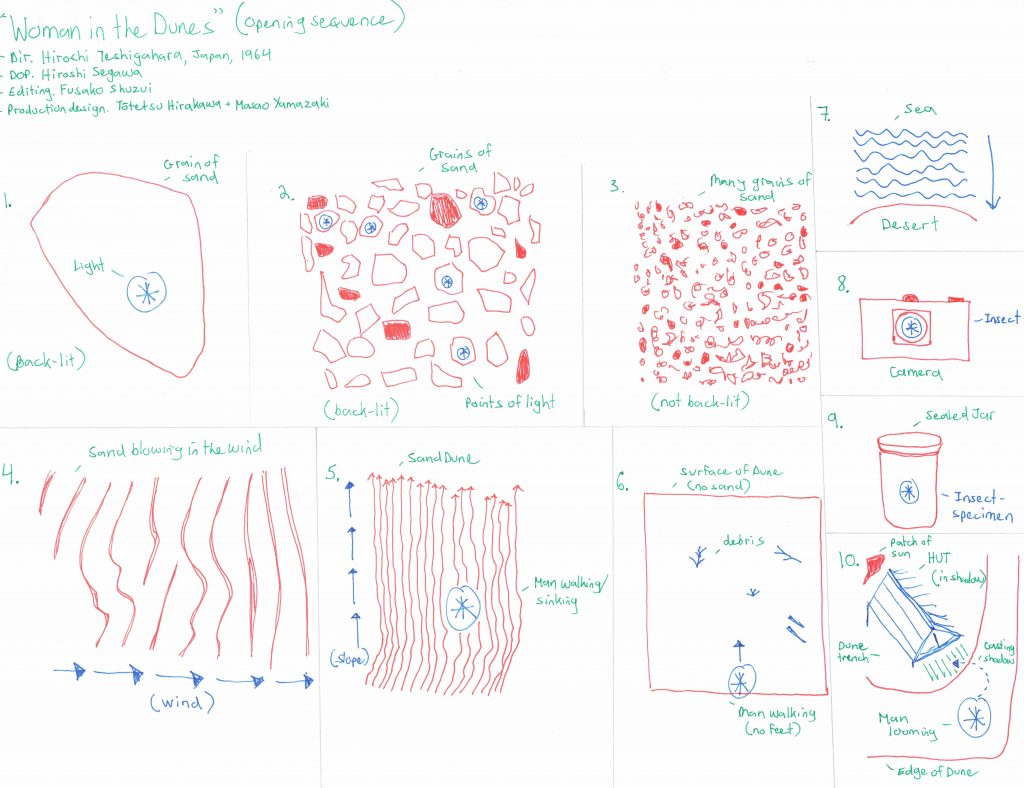
Commentary:
A single grain of sand is the atomic unit of an unfathomable whole. We watch it expand in increments, changing shape and pattern, forming multitudes which gradually give way to a desert nothingness. An abyss. And once the abyss in Woman in the Dunes is established, the human being can take the stage, as solitary and minute as the grain of sand. This spatial narrative could also be read as follows: Individual → group → society → system → oppression. It’s the physical presence of the man which turns the sand dune into an uphill slope. Why does he tread there and endure such arduous terrain? Because he seeks. The value of things is not self-evident. The world is a mystery to be solved, or mined.
The single grain of sand holds a secret: a glimmering spot of light (designated as an encircled blue asterisk). And this spot of light is inexplicably trapped in rock, somehow unable to seep through and escape into the surrounding atmosphere. Later on, we learn that what is trapped is water—water all along. Sand dunes are waves. The desert is an ocean. No metaphors. It’s science—good science! The map shows that the light trapped in the sand grain matches the man who sinks into the sand while scaling up the dunes. The man moves like a conqueror, taking pictures and caging exotic insects—at least that is what he thinks or wishes to believe. From a ridge he looks down and observes a hut at the base of the dunes. He casts his heavy shadow over it. He feels he’s in control, outside and looking in, like the gaze of the ethnographer half of whom is still safely at home. But according to the map we can see he is already lodged inside this new environment like one of his specimens, and when the lid is removed at last to free him, he takes no notice of it whatsoever, or smiles and carries on. The jar of life contains everything he needs—house, food, woman—and a project: the secret of the sand which captivity has made apparent to him.
Ironically, the man’s captivity frees his mind to examine the smallest details which the modern world casts into darkest oblivion, in all its size and splendor and simultaneity of information. What better way to concentrate on something with all one’s might than by being denied one’s freedom to do anything else? Distraction gets us nowhere. Sand? Brush it off. Sweep it up. It’s irksome dirt. But sand is not dirt. What is it, then? Not a question one is likely to ever ask oneself in all seriousness unless it is the only one available. It’s true that you can’t draw water from a stone, but if you watch and wait, listen to the stone, find its pulse—it’s in there somewhere—and return in the morning refreshed and eager for revelation, the stone may surprise you in declaring that it belongs, like us, mostly to water. When the man discovers, at first by chance, that the water in sand can be trapped within the dunes, not drained or otherwise extracted, he is by some cosmic logic freer than he’s ever been, seeing for himself the fruits of confinement.
Map 3: “A Film from Old to New”
Case study: Locke (Steven Knight, USA, 2014)
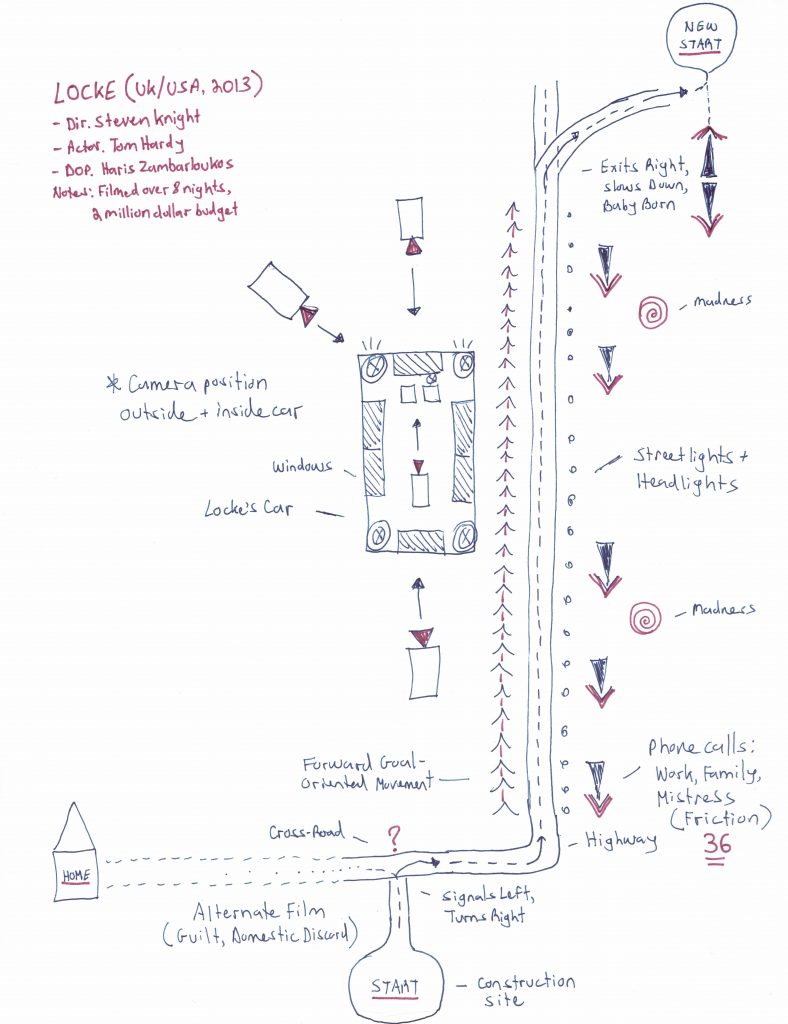
Commentary:
This is an attempt to map out an entire film—its main movement, shape, and double-directionality. It’s also the simplest map, perhaps because it is a rather simple film—though as I came to discover, simplicity of story and economy of space can bring into focus interior complexities that have little outlet in more cluttered narratives and, if credibly performed and directed, can percolate to the surface of the surrounding spatial environment. Locke is set during a single night, entirely within a moving car, and features only one character onscreen (the rest exist offscreen during phone conversations). The space and time of the film could not be more constrained. Setting becomes story, in a sense. At the start of the film, Locke is supposed to turn left to return home. One goes home after work, at the end of the day, home to reunite with family and to rest. But… a right turn also leads home, the start of a new home. The crossroads reserved for climaxes occurs in the very first scene. On the other side of a long stretch of highway destined for London, Locke’s mistress awaits in a hospital, having gone into labor with their unplanned child.
Locke signals left but turns right—thinks “avoidance” but chooses to confront the consequences of his actions. The drive is incredibly smooth and straight; the car glides like a cloud, coasting through the sky. He might welcome a few obstacles or some traffic to take his mind off the gravity of the situation and this great turning point in his life, full of risk and potentially cataclysmic. No traffic lights or stoppages, though. The trip would be completely undramatic, cinematically speaking, all guilt and trepidation locked inside the trunk of the mind off-limits to the camera, if it were not for the astonishing 36 phone calls he receives from his wife, son, mistress, and co-workers. These phone calls (some of which he makes, but most of which he takes, like blows to the chin) act as brakes resisting this strident bird in flight, a reduction to be understood not in terms of speed but conviction. We may turn our lives around at any time, right? A bird in flight may be free, whereas a human being in flight seeks freedom from his life or himself. And who knows, a bird may be rushing home too as opposed to frolicking wildly with nothing to do but fly.
From this life now to the new life yonder spans the uncanny limbo of psychological unrest—the great tides of fear, excitement, courage and conscience clashing in a mind that can finally be seated to reflect on itself and the life it has made. Phone calls from Home #1 strike as points of friction (“turn back!”), interspersed with phone calls from Home #2 (which may or may not become a home) that grease the mind onward and onward (“there’s no turning back on a one-way street”). But what this means is that Locke is actually on a double highway forward and backward. Increasingly, the phone calls become like mental car crashes that induce a confusion or madness (depicted on the map as a spiral). We can’t move forward and backward, we can’t be in two places at once, we can’t be two people, especially two people whose actions disagree. Head spinning, heart pounding, world caving, his foot remains sure on the gas pedal.
Map 4: “The Many Lives (and Lies) of a Film”
Case study: Taste of Cherry (Abbas Kiarostami, Iran, 1997)
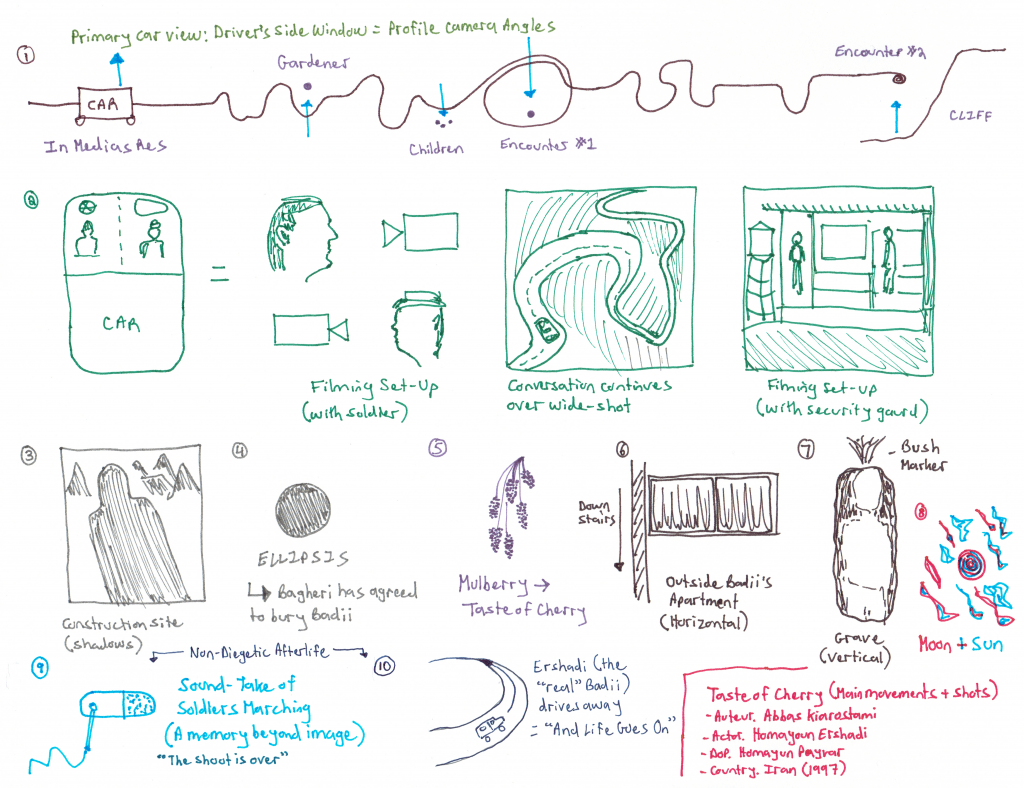
Commentary:
Here is an attempt to map a more complex film in its entirety by focusing on key movements (in a musical sense) and emblematic shots (not necessarily of specific scenes but as scenes in and of themselves).
Since Taste of Cherry begins in a moving vehicle, a car, it feels like it begins precisely in the middle—in medias res. There is nothing planned or routine in the main character Badii’s route through the streets of Tehran. It is not a route at all, for he is not on his way to or from anywhere. He is searching for someone to bury his body upon committing suicide—a desire not only to die but to disintegrate and return to the earth. Under a bright sun and surrounded by bustling activity, it seems unlikely he will find anyone willing to discuss death, let alone suicide, let alone bury him when the time comes. The people he meets have their hands full—in this sense they lead full lives—with Badii like a hawk ready to swoop down upon the innocent revelers of the everyday, completely at one (at peace) with his nihilism.
The second illustrated movement breaks the fluidity and realism of the first. Badii offers a young soldier a ride back to his camp and convinces him to make the most of his free time by taking a leisurely drive. It seems the two are seated side-by-side in the car, as we would expect them to be, especially in conversation; but in fact they are never shown together in the same shot, hence the same space. They converse together only in the implied fictional world of the film, for in reality the man seated next to them is the director, Kiarostami, who asks questions and delivers prompts to propel the conversation towards the grim yet deeply personal subject of death. If actors are not present in the same shot, they are not, ontologically speaking, in the same world. The conversation is built on a foundation of deception—it never was. But had it been allowed to be, what it would gain in accuracy it would lose in honesty, urgency, and dead earnestness. For conversation to flow like life itself yet drain away in a sea of nihilism, a part of Badii’s speech must always be addressed to himself in his unbearable solitude. Separate conversations form a measure of reality more compelling and perfect than any photographic verisimilitude. This comes to a head when the conversation persists over an extreme wide shot of the car driving along the winding roads of rural Tehran. Anyone could be in that car. That could be anyone’s car. What does it matter if they are both in the car or not? The sound of their voices and rumble of the engine places us within the car’s peaceful privacy. The wide shot (section 2, image 3) dawns as the POV of fate itself—the road of life full of twists and precarity, but at least there’s only one road. The fork in the road is a delusion of anticipated regret: we were always going to go that way—one with the road. The same road forks and, eventually, re-converges.
I chose to draw the scene with Badii and the security guard (section 2, image 4) because they converse in the same shot albeit in different frames created by the various windows and partitions of the watchtower. On this occasion, the conversation we hear is the one we see, but that doesn’t mean the conversation counts for anything more than superficial (photographic) connectedness. The human connection fails to materialize in this elevated space, and nothing of importance (for Badii especially) is accomplished, hence the brevity of the scene. The security guard refuses to leave his post, his perch: he is good for watching, not acting. Unlike Badii, he accepts loneliness, takes some pleasure in his remoteness from others, and perhaps finds meaning in the clarity of being cut off from the world. The section ends with Badii descending a ladder back to the ground of the city, giving his consent to the world yet confiding only in the hope of leaving it once and for all.
The final section of the film, including the reflexive epilogue, is drawn as a series of symbols. The film’s documentary realism becomes poetic, if not allegorical at this point. (“What realism?”, Kiarostami might ask.) The colors of the images are significant here: gray, purple, brown, a braid of red and blue. The ashen truth of Badii’s irreparable despair is a condition so sapped that a taxidermist (quite fittingly) named Bagheri finally agrees to bury him. The taste of cherry, or mulberry, from which the film takes its title, is Bagheri’s attempt at a jolt of wisdom, an anecdote in which his despair was quite literally cured by this lively taste. But this taste (of knowledge, of life experience, of little things) fails to reach and rekindle Badii’s spirit. He is like a ghost, we must remember, made plain in the film’s only manageable metaphor—the shadow (#3).
Pictures 6 and 7 depict Badii’s physical and metaphysical graves, the one from which he longs to escape and the one in which he shall have his eternal reprieve: to be free from… from freedom itself, I suppose. (As we saw in Woman in the Dunes, freedom thrives in the voluntary confinement to particulars, in being externally subject to a finitude that is fundamental to yet forsaken by the human condition’s delusion that death can somehow be cheated.) We never found out why, exactly, Badii is so deeply beholden to the prospect(lessness) of death—do we have a right to know?—and he seems to suggest there is nothing really to know about him in this regard. That’s the trouble: the void, the crush of too much life, and the weakened soul’s reply: “I’ve had enough.” A lonely and unfeeling life inside an apartment within a massive metropolis is a kind of grave-like sleep. Lying in the grave, the moon is bright like the sun (#8)—the thick curtain of night is lifted all at once, albeit briefly, by all-encompassing flashes of lightning. Goodbye world—you were never cruel, just chaotic. Your beauty meant there could not be a meaning behind such a face. You taste sweet only when ripe—when young! Oh, where has my youth gone? How could such a spring dry up? Why did I fail to flower once more?
Pictures 9 and 10 show what I am calling the film’s afterlife. Badii is alive and well. His real name is Ershadi—you can see him standing around, smoking, chatting with Kiarostami. They are shooting an earlier scene of the film featuring a group of soldiers marching along the film’s winding terrain. Kiarostami then declares the film shoot over, except for a final take of wild sound that does not call for any directorial intervention. (Cameras frame the world, whereas sound recorders take it all in.) I see here, in this humdrum afterlife, an alternative finality to Badii’s implied death that can only be shown by crossing over into a film’s nether-regions: the end of the film shoot, which is the end of life pouring into the film, the closing of camera and microphone, eyes and ears, so that the mind can edit (think) the living pieces into a whole. The camera documenting the end of the shoot catches Badii/Ershadi’s car driving away into the distance, continuing the epic yet intimate journey that a film can merely hint at. The film’s final image is of Badii/Ershadi still searching. In this sense the film commits its own kind of aesthetic suicide, gaining foreign wings.
While fictions are fated to bring life’s journey to some sort of end (in this case, Badii’s death, which is the end mythologized), the film’s documentary/reflexive epilogue declares the reverse: nothing ends. Or as Kiarostami would prefer, life goes on. But of course, that too must come to an end. Fade out, roll credits. Infinity can neither be filmed nor drawn—not by me anyway.
We welcome proposals for this section of our site devoted to creative pedagogies. Should you be interested in contributing a feature spotlighting an innovative approach to teaching screen media, please submit a short description and brief bio to nrftsjournal(AT)gmail(DOT)com.

